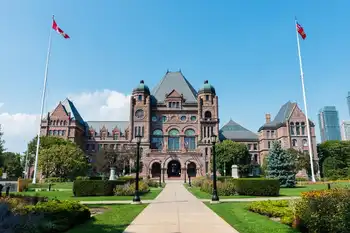Connecticut to waive students loans in green jobs
EAST HARTFORD, CONNECTICUT - Paul Goulet hopes Connecticut will help him get from under nearly $8,000 he's borrowed for college after losing his job in a paper manufacturing plant.
Goulet, 55, is a student in environmental studies at Goodwin College in East Hartford, aiming to find work in wastewater treatment. State legislation that would waive thousands of dollars in loans would benefit him and other students who earn degrees or certificates in green technology and other jobs.
"Everything I've taken out since October is on the student loan program," he said. "Any little bit would help, especially with the job market the way it is."
Loan forgiveness programs aren't new — states use them to entice medical professionals to rural areas, steer teachers to certain subject areas and attract farmers to local agriculture.
The legislation comes as the White House is emphasizing the importance of green works and job creation. President Barack Obama announced in January $2.3 billion in tax credits — to be paid for from last year's $787 billion stimulus package — that he said would create 17,000 green jobs. The money will go to projects including solar, wind and energy management.
Connecticut's proposal could break new ground. Trying to boost its work force in high-growth green technology, life sciences and health information technology, the state would annually forgive as much as $2,500 of federal and state education loans for up to four years, or 5 percent of loans, whichever is less.
To qualify, students must earn a bachelor's or associate's degree and work in Connecticut for at least two years.
Joan McDonald, economic development commissioner, said Connecticut is seeking to boost its population of young workers.
"What we're doing here is to encourage people to come here and stay here," she said.
The legislation, which would earmark $6 million, cites green technology, life science and health information technology because prospects are good for job growth in those industries and Connecticut is home to employers in fuel cell technology, pharmaceutical products and other high-tech industries, she said.
The bill is not a sure thing in the legislature. Members of the House-Senate Committee on Higher Education and Employment Advancement will decide soon whether to bring it up for a vote, said Sen. Mary Ann Handley, co-chairwoman of the committee.
Retraining unemployed workers is the focus of another bill that would provide more immediate help to the jobless, she said.
"We need to think about what direction to go," Handley said.
Loan forgiveness for massive medical school loans is succeeding in drawing doctors and other health professionals to underserved rural and urban areas.
David Bowman, a spokesman for the Health Resources and Services Administration, said the National Health Service Corps is budgeted for $142 million and has received $300 million in economic stimulus money.
Nearly 4,000 doctors, clinicians, dentists and other health practitioners use the program, and the number is projected to jump to nearly 5,700 by next year.
"The incentives do work," Bowman said.
In Pennsylvania, an agriculture loan forgiveness program provided an average of $620 in loan forgiveness to 111 aspiring farm workers in 2009, up from 108 the previous year, said Keith New, spokesman for the Pennsylvania Higher Education Assistance Agency and American Education Service.
North Dakota has loan forgiveness programs to encourage teachers to work in shortage areas such as math, science and English and for workers in occupations in science, technology, engineering and math. Teachers who work at least one academic year in the state can write off $1,000 in student loans annually for three years. Workers in science, technology and engineering occupations can eliminate $1,500 annually for up to four years if they work in North Dakota at least one year.
"It's a big plus for smaller school districts," said Peggy Wipf, financial aid director at the North Dakota University System.
Edward O'Connor, dean of the School of Health Sciences at Quinnipiac University, said Connecticut's proposal would fill a need. The Hamden, Conn., school will probably graduate 30 students who will work in pharmaceutical and biotechnology labs and clinical settings, up from 10 three to five years ago.
"The pipeline is building," he said. "In general, there's a very strong job outlook."
But an executive at UTC Power, the United Technologies Corp. subsidiary that manufactures fuel cells, said the market for new forms of energy — not legislation — will determine employment.
"It depends on people buying fuel cells and greater volume," said Mike Brown, vice president of government affairs and general counsel at the South Windsor company.
One hurdle to Connecticut's program is figuring out what green technology is.
"Green jobs are hot, but what is it?" said Mike Polzella, a research analyst at the state Department of Labor.
Easier to define, he said, are life sciences, which study gene cells, tissues and chemical and physical structures of organisms, and health information technology that uses electronic records for medical or health information.
The proposed legislation defines green technology to include developing alternative fuels or new ways to generate energy and invent or design chemical products and processes to eliminate hazardous substances.
There is no widely accepted definition of green jobs or green employment, said Richard Clayton, chief of the Bureau of Labor Statistics' division of administrative statistics and labor turnover. The federal government is spending $7.8 million to help come up with a classification, he said.
"It seems reasonable if people want to assess this portion of the economy, whether it's growing or contracting," Clayton said.
Goulet, who is working toward an associate's degree, worries that green technology, defined or not, may be more hype than reality.
"My only concern is that there's so much talk about green jobs, I'm just wondering if there will be green jobs or if that's just a fallacy," he said. "I feel this was a second chance for me."
Related News

Biggest offshore windfarm to start UK supply this week
LONDON - An offshore windfarm on the Yorkshire coast that will dwarf the world’s largest when completed is to supply its first power to the UK electricity grid this week.
The Danish developer Ørsted, which has installed the first of 174 turbines at Hornsea One, said it was ready to step up its plans and fill the gap left by failed nuclear power schemes.
The size of the project takes the burgeoning offshore wind power sector to a new scale, on a par with conventional fossil fuel-fired power stations.
Hornsea One will cover 407 square kilometres, five times the size of the nearby…




